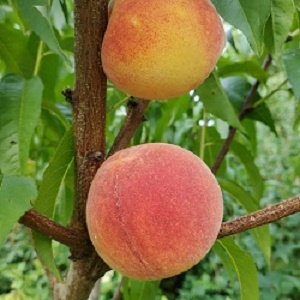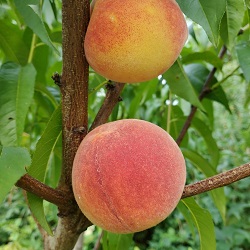Peach : INTREPID Semi-Dwarf (Bailey)
$63.95
Although most tree ripened peaches offer a sublime fresh eating experience, Intrepid is an overwhelming family favourite with unequaled wow power. Selected at the Sandhills Research Station in North Carolina in 1990, it seems largely unknown as yet. We expect this to change, as it appears to match the cold hardiness of it's parent Reliance, while improving on size, flavour, texture and firmness. Late blooming combined with outstanding frost tolerance means fruit set is usually heavy enough to require significant thinning. Intrepid is also noted for high resistance to bacterial leaf spot.
SELF-FERTILE | ZONE 4/5 | HARVEST: LATE AUG
Everyone would love picking peaches off their very own tree, but for many of us here in Canada it remains an elusive dream. The bitter, relentless cold of some recent winters took a terrible toll, but true to their fickle nature, some trees survived in unlikely locations, while others in supposedly ideal settings gave up the ghost. Protection from frigid winds is almost certainly a benefit. The take-home message? Be aware of the risks, but stay cautiously optimistic and keep planting a tree or two.
1.25-2m (4-6ft.) bareroot trees
8 reviews for Peach : INTREPID Semi-Dwarf (Bailey)
Only logged in customers who have purchased this product may leave a review.
Growing Tips
Peach trees are usually unaffected by pests or diseases in northern areas, the occasional exception being peach leaf curl. PLC is not a fatal problem but it does need to be controlled if you get hit with it. Look for crinkled or puckered foliage in spring. Remove affected leaves and compost them. A good preventative is to spray the dormant trees with copper in the fall and again in the spring before bud break (See page 63). Do NOT spray during the growing season as it will cause all the leaves to drop.
Prune your peach trees in May, once they have leafed out, but don’t prune off all the new wood that grew last summer. Peach trees fruit on that last season growth. Trim any dead or winterkilled branches and leave most of the new wood. Occasionally you can make a few bold cuts back to a vigorous branch closer
to the trunk if your tree becomes too leggy. As the tree matures, you may want to thin out the branches quite aggressively.
One of the key factors that determines cold-hardiness for tender fruit trees such as apricots and peaches is how well they harden off in the fall. Any activity that stimulates growth should be avoided after August 1. This includes fertilizing, overly frequent watering and pruning.
Stop! Do not plant your peach or nectarine tree in that sheltered nook of the south side of your house. Although well meant, this very common mistake is almost certain to doom your new tree. Of course extreme cold is hard on peach trees, but the warm noonday sun on a late winter day is actually worse. A dark tree trunk will warm up considerably but then the temperature drops and the bark refreezes. To avoid this fluctuation, look for a planting site in the winter shade (north side) of a building or group of evergreens. In other word, close enough to the building to be shaded from the low winter sun but far enough back to get full exposure in the summertime when the sun is high. The goal is uniform cold so as
not to interrupt dormancy. Some growers white wash the trunks and lower branches of older peach trees in late fall with a cheap interior latex paint to protect from sun damage in winter. Young trees should have trunks wrapped with a light coloured blanket or covering.





Edwin Wiebe (verified owner) –
The service was great
David Alguire (verified owner) –
Mathieu (verified owner) –
Great as always, can't wait next year to taste those
Inna (verified owner) –
Josh P. (verified owner) –
Very nice tree, arrived in better shape than trees from other online companies.
Denis Carrier (verified owner) –
Anonymous (verified owner) –
Peach leaked out well. Got great delivery service.
Jolyanne B. (verified owner) –